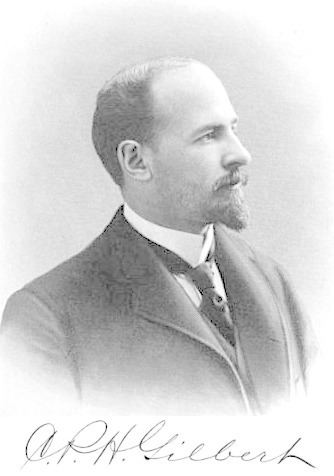Nationality American Occupation Architect | Name C. H. Role Architect | |
 | ||
Full Name Charles Pierrepont Henry Gilbert People also search for Joseph Raphael De Lamar, Harry Ford Sinclair, Robert W. Gibson, Kevin Roche, Morton Freeman Plant Structures Harry F Sinclair House, Joseph Raphael De Lamar, Felix M Warburg House, Otto H Kahn House, Morton F Plant House | ||
Charles Pierrepont Henry Gilbert (August 29, 1861 in New York City – October 25, 1952), most often referred to as C. P. H. Gilbert, was an American architect of the late-19th and early-20th centuries best known for designing townhouses and mansions.
Contents
Background and early life
Gilbert's family comes of English and New English ancestry. One of the members was Sir Humphrey Gilbert, to whom Queen Elizabeth I of England granted a patent for the colonization of North America. Sir Humphrey's ambitious plans ended when he was lost at sea with most of his company on his return voyage from the exploration of Newfoundland. Other members of the family, however, soon planted the name in North America.
His father was Loring Gilbert, a direct descendant of John Gilbert, the second son of Giles Gilbert of Bridgwater, Somerset, England, who came to America early in the 17th century and settled at Dorchester, near Boston, and died at Taunton, Massachusetts, in 1654. Loring Gilbert was a leading commission merchant who had a successful career. He married Caroline C. Etchebery, and they had one son, Charles Pierrepont Henry Gilbert. Loring Gilbert died in 1893.
C. P. H. Gilbert received a careful education, studying both in America and in Europe, such as the École des Beaux-Arts in Paris. After being prepared for college he took special courses in civil engineering and architecture, and later studied painting, sculpture and the fine arts in general. After college, he began practical work as an assistant in the office of a prominent firm of architects, where he received the training necessary to prepare him for engaging in his own business. As a young man he designed buildings in the mining towns of Colorado and Arizona before returning to New York around 1885.
Career
In 1886, at the age of twenty-five, Gilbert began practicing as an architect in New York City, and received commission to design buildings of all kinds. One of Gilbert's first projects was the design of fourteen brownstone rowhouses that now form a part of the Manhattan Avenue Historic District. Gilbert designed the block for Hoboken developer John Brown in 1886.
Another noteworthy building was the 1888 Richardsonian Romanesque mansion at Eighth Avenue and Carroll Street in Park Slope, Brooklyn for Thomas Adams Jr., a chewing gum magnate. From 1893 on, Gilbert had a very large business, which grew steadily. In addition, he was a director or a stockholder in a number of large manufacturing companies outside of New York.
He saw action during the Spanish–American War of 1898, where he was a veteran. After the war he returned to New York.
By 1900 Gilbert had a reputation as a specialist in designing opulent townhouses and mansions. Among Gilbert's Fifth Avenue palazzi is the 1905 Neo-Renaissance mansion of Morton Freeman Plant, son of railroad tycoon Henry B. Plant. Through the 1920s he designed more than 100 New York City mansions in various styles, several of them along Fifth Avenue have now been re-purposed for institutional use. In education, client list and architectural style, Gilbert largely followed in the footsteps of Richard Morris Hunt, whose petit château on Fifth Avenue for William Kissam Vanderbilt set a model for French Late Gothic limestone châteaux to house the elite of the Gilded Age. Amongst Gilbert's clients were wealthy and influential industrialists and bankers such as Harry F. Sinclair, Joseph Raphael De Lamar, Felix M. Warburg, Otto H. Kahn, Adolph Lewisohn, Augustus G. Paine, Jr. and families such as the Baches, Reids, Wertheims, Sloanes and other. Gilbert also designed a number of mansions and buildings on Long Island and in upstate New York in the 1920s.
Gilbert retreated from public life, and by the late 1920s stopped designing any new houses. He retired to Pelham Manor, New York in Westchester County, where he died on October 25, 1952 at his home on 216 Townsend Avenue, at the age of 92. He is interred at Woodlawn Cemetery in The Bronx, New York City.
Memberships
Gilbert was a member of numerous professional and social organizations, amongst them the Chamber of Commerce of the State of New York, the Architectural League, the Society of Colonial Wars, the General Society of the Sons of the Revolution, the New England Society, and the Fine Arts, Metropolitan, Union League, Lawyers', Riding, Racquet, Ardsley, Colonial, Country, and Nassau Country clubs of New York. He also was a Fellow of the American Institute of Architects, and a veteran of Squadron A, the cavalry organization of the New York National Guard.
Family
Gilbert was married to Florence Cecil Moss, daughter of Theodore Moss of New York City, and had two children: Dudley Pierrepont Gilbert and Vera Pierrepont Gilbert. He lived at 33 Riverside Drive and had a villa in Newport, Rhode Island at Ochre Point.
Works
Some of Gilbert's works include:
